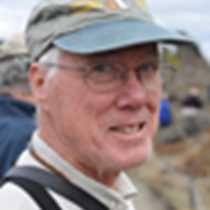Petersburg and Stephens Passage, Southeast Alaska
Petersburg is a working Alaskan fishing town. No t-shirt and curio shops lining the streets here. We spent our morning in Petersburg with a walk up a boardwalk trail to a muskeg bog and a stroll through the quiet Sunday morning streets with, perhaps, a visit to Alaska’s favorite hardware store. Some took the opportunity of a floatplane ride over the nearby Stikine Ice Field and LeConte glacier, which flows from it. Early residents of Petersburg took advantage of this free ice to ship fresh Alaska halibut by steamship to Seattle, and from there by rail to population centers around the country. From this start grew Alaska’s most prosperous fishing community.
We departed Petersburg and headed north up Frederick Sound and into Stephen’s Passage, between Admiralty Island and mainland Alaska. We were in search of humpback whales. With the wind at our back and a clear Alaskan sky overhead, it was a most pleasant search. And find them we did! Spouts seen off in the distance first announced their presence. We had several from which to choose; Capt. Carden, at the helm, chose to follow two whales that were actively feeding in close coordination. They seemed oblivious to our presence, repeatedly making short feeding dives along a tidal riff, against a backdrop of magnificent Alaskan scenery that included the Devil’s thumb, a 9,077-foot high horn on the Alaska-Canada border. Humpbacks in these waters are newly returned from their winter in Hawaii. Feeding very little, if at all, in Hawaian waters, they lost considerable body fat that must be replenished during the short, intense Alaskan summer. Over and over the whales descended, showing their flukes as they dove; they then arose, mouth agape and ventral pleats distended with water and, hopefully, small schooling fish. The distinctive patterns on the undersides of the flukes are perhaps our most useful tool in the study of humpback whale biology. From photos such as this we can determine the movements, associations, reproductive success, and much more of this individual whale. Will the association of these two whales continue throughout this season or even over future seasons? The next set of photos might answer that question. Toward that end, photos taken today will be added to the catalog of sightings. We can enjoy an afternoon marveling at these great creatures and, in the process, contribute a small piece to our emerging knowledge of their biology.
Petersburg is a working Alaskan fishing town. No t-shirt and curio shops lining the streets here. We spent our morning in Petersburg with a walk up a boardwalk trail to a muskeg bog and a stroll through the quiet Sunday morning streets with, perhaps, a visit to Alaska’s favorite hardware store. Some took the opportunity of a floatplane ride over the nearby Stikine Ice Field and LeConte glacier, which flows from it. Early residents of Petersburg took advantage of this free ice to ship fresh Alaska halibut by steamship to Seattle, and from there by rail to population centers around the country. From this start grew Alaska’s most prosperous fishing community.
We departed Petersburg and headed north up Frederick Sound and into Stephen’s Passage, between Admiralty Island and mainland Alaska. We were in search of humpback whales. With the wind at our back and a clear Alaskan sky overhead, it was a most pleasant search. And find them we did! Spouts seen off in the distance first announced their presence. We had several from which to choose; Capt. Carden, at the helm, chose to follow two whales that were actively feeding in close coordination. They seemed oblivious to our presence, repeatedly making short feeding dives along a tidal riff, against a backdrop of magnificent Alaskan scenery that included the Devil’s thumb, a 9,077-foot high horn on the Alaska-Canada border. Humpbacks in these waters are newly returned from their winter in Hawaii. Feeding very little, if at all, in Hawaian waters, they lost considerable body fat that must be replenished during the short, intense Alaskan summer. Over and over the whales descended, showing their flukes as they dove; they then arose, mouth agape and ventral pleats distended with water and, hopefully, small schooling fish. The distinctive patterns on the undersides of the flukes are perhaps our most useful tool in the study of humpback whale biology. From photos such as this we can determine the movements, associations, reproductive success, and much more of this individual whale. Will the association of these two whales continue throughout this season or even over future seasons? The next set of photos might answer that question. Toward that end, photos taken today will be added to the catalog of sightings. We can enjoy an afternoon marveling at these great creatures and, in the process, contribute a small piece to our emerging knowledge of their biology.




